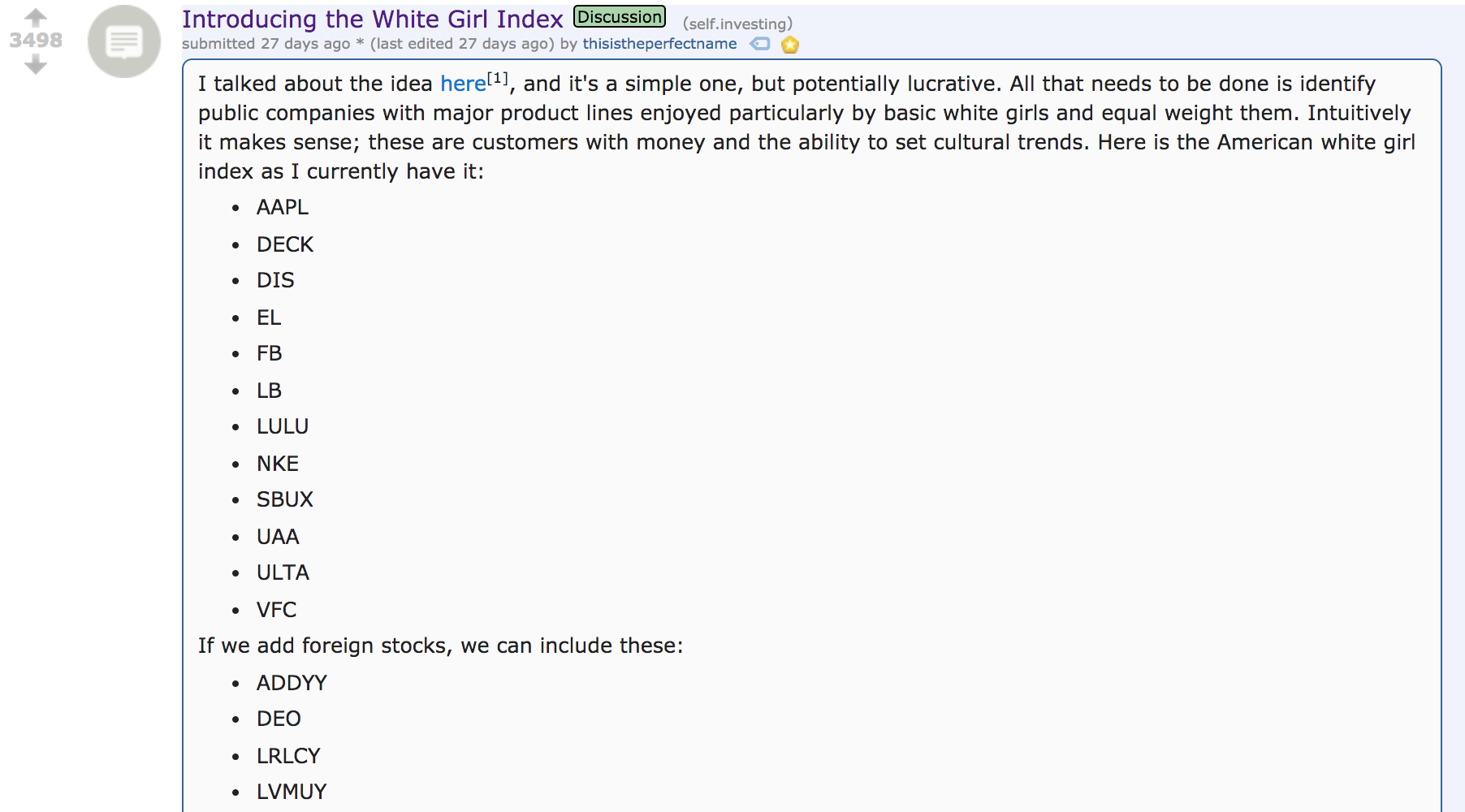Mid-conversation with a female friend, an investor who goes by u/thisistheperfectname on Reddit had an epiphany: “White girls crush the market.”
The “basic white girl,” he says, “has high discretionary spending and patronizes a lot of companies with strong brand power,” so the stocks of those companies are particularly strong.
“My friend is one such stereotype,” he tells MEL, “and she observed that she spends a ton of money at Starbucks and Disneyland in particular, and that’s even before getting into owning a cracked white iPhone and more athleisure than you can shake a stick at.” Thus, they came up with a unique investment strategy called the White Girl Index: a portfolio of the most popular “white girl” brands, such as Starbucks, Target and Lululemon. They posted it on Reddit’s r/investing, and it quickly went viral.

I know nothing about investing, so before I raided my girlfriend’s closet for her favorite brands, I consulted a few financial experts.
Mike Menninger, a certified financial planner, advises that before rushing into things, it’s important to find out whether this is a “chicken-or-egg” scenario: Does the success of these companies come from strong marketing or the products themselves?
For example, Lululemon: “The product manufacturers know that demographic — rich white girls — is where the money is. So, is it the product manufacturers’ marketing of high-end products the cause, or is it the rich white girls buying those particular products? Hence, the chicken and the egg.”
He concludes: “I think it’s both: Marketing creates the awareness, then the purchase, then the trend, and the snowball has been started.”
That’s where the investment gets risky, Menninger says. If for some reason Lululemon falls out of favor from a marketing standpoint, the stock would plummet because it’s the brand marketing, not the product itself, the demographic is buying into.
He says the current economy might be another factor. Affluent households are flush with cash, so spending on nonessential items like Starbucks and brand-name athleisure is up. So it’s smart to get more specific about the targeted demographic and “specifically identify the market … it becomes a question of the corporate management properly advertising and targeting the right audience. Advertising = money = profits = stock performance.”
The last potential flaw Menninger sees in the White Girl Index is “the question of who is buying the stock. Is the demand on the stock (causing stock price to go up) being driven by institutional investors buying millions of shares at a time, or is the stock price driven by the retail investors (Joe the plumber, or Susie the shopper) who buy a couple hundred at a time?” If it’s the latter, he says, the stock price will be more volatile, because “the retail investor is incredibly more emotional. … Once the stock price begins to go down, watch for that bad boy to plummet more quickly.”
Danny Kofke, author of A Simple Book of Financial Wisdom: Teach Yourself (and Your Kids) How to Live Wealthy With Little Money, is the father of two girls about to enter this demographic. He says it’s a fun idea, but he urges similar caution.
“I have two daughters who are 14 and 11, and while they are not into all of these items at this point in time, they like to buy things/ask for gifts from some of these companies,” he says, adding that he foresees them getting into the rest of the list as they get older. Kofke ran a backtest, looking into the stocks’ previous performance. In the past five years, he says, “all but two of the companies had increases in their stock price! Pretty cool.”
Redditor thisistheperfectname ran the same test over 10 years and found similar results: “These companies almost tripled market performance over the last decade.” Of course, “there is no guarantee that their future growth will approach their growth as they built their brands. … The index is backwards-looking, [so] the companies selected are the ones that have already made it with the target demographic.”
So what is a new investor to do? Kofke urges caution. “I still think a 401(k) is the best route for many — especially if you get a company match,” he says. “But I am really intrigued by this list. I think for people who want to invest outside of their workplace plan, this might be something to consider.”
Menninger says he embraces the idea of “not-so-sophisticated investors” investing in products they like and use, because it helps them form a deeper understanding of those products and “feel that they’re contributing to their stock price by buying their products, and they believe in the product. Apple stock is something they can put their fingers on, just like Lululemon.”
However, he doesn’t embrace the idea of investing solely in “products purchased by ‘white girls’”:
“In the end, [it’s] an interesting trend, but we need to go back to the basics of investing. The fundamental value of a stock’s price is its earnings (profits), its dividend and its expected earnings and dividend growth. From there, the movement of the stock is based on Economics 101 – supply and demand. If more people want to buy the stock, then the price will go up, and vice versa. Thus, you may find some of these stocks as being ‘trendy’ and rising faster than their fundamentals would otherwise command. Let’s backtest this author’s concept in a recession to see if these white girls’ stocks outperform the market or underperform. Which companies’ fundamentals are strong enough to survive a recession?”
As for the creator of the White Girl Index, he agrees. “I don’t use this ‘index’ myself, or any other for that matter,” he tells MEL, “but I own several of those names in large quantities. If you wanted to duplicate this idea yourself, the easiest way is probably through a pie on M1 Finance [an investment app] — that way you can set each company’s weight and have it buy fractional shares as you contribute money.
“You would also have to shuffle names in and out as they fall out of fashion and new ones appear,” he adds. “I would also recommend imposing profitability requirements if you wanted to duplicate this yourself to separate some of the chaff. Looking at you, Snapchat.”

